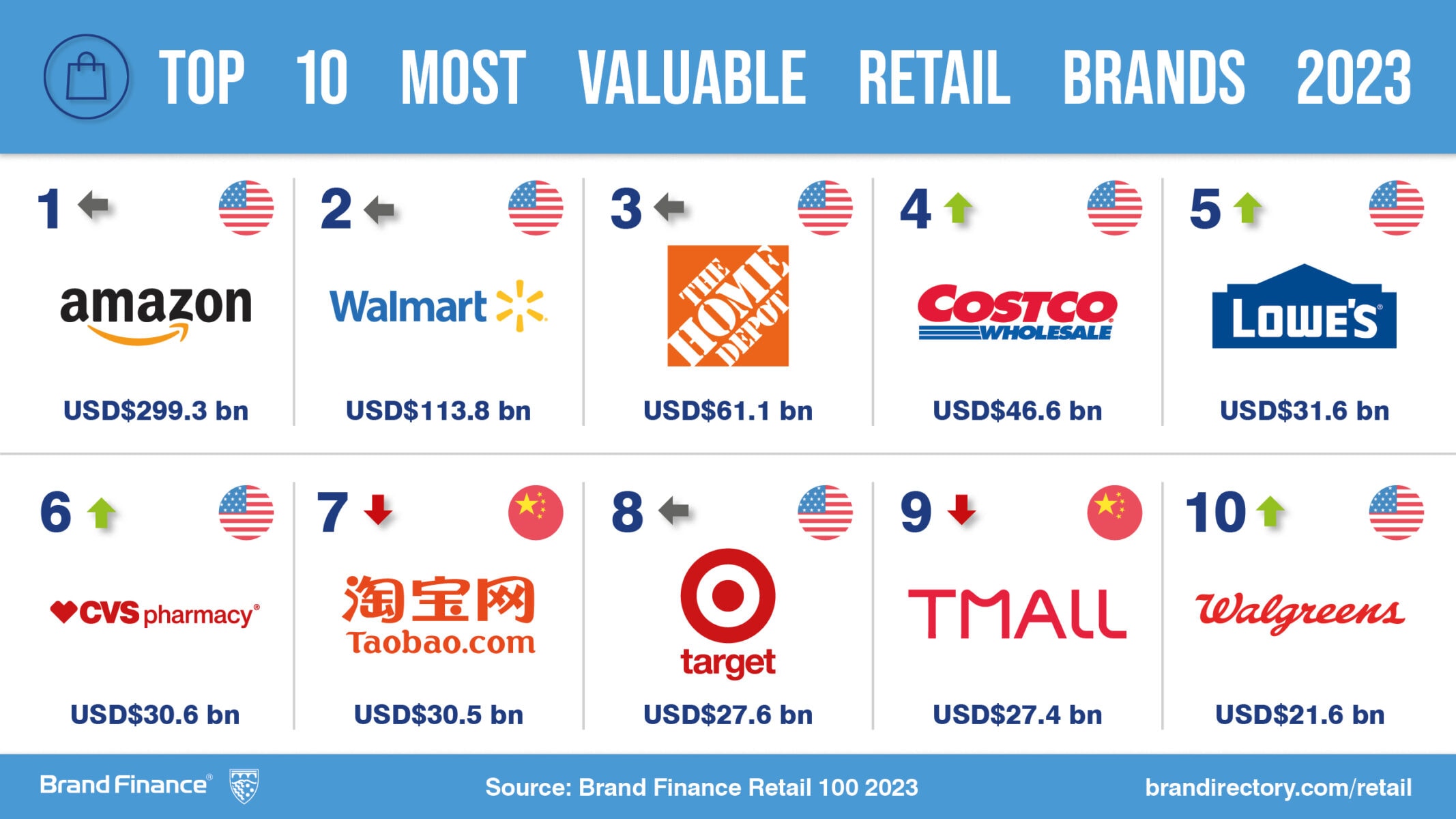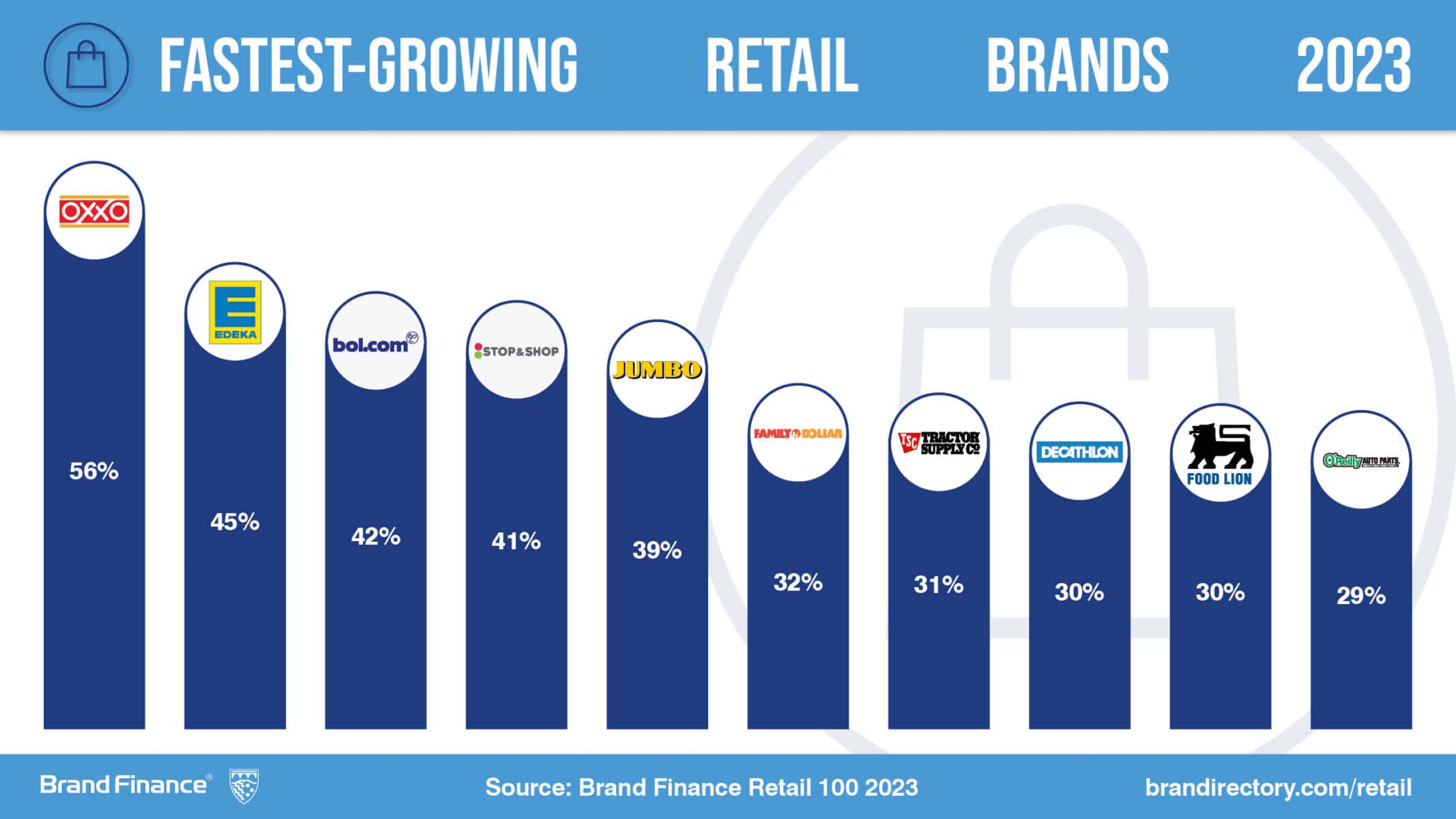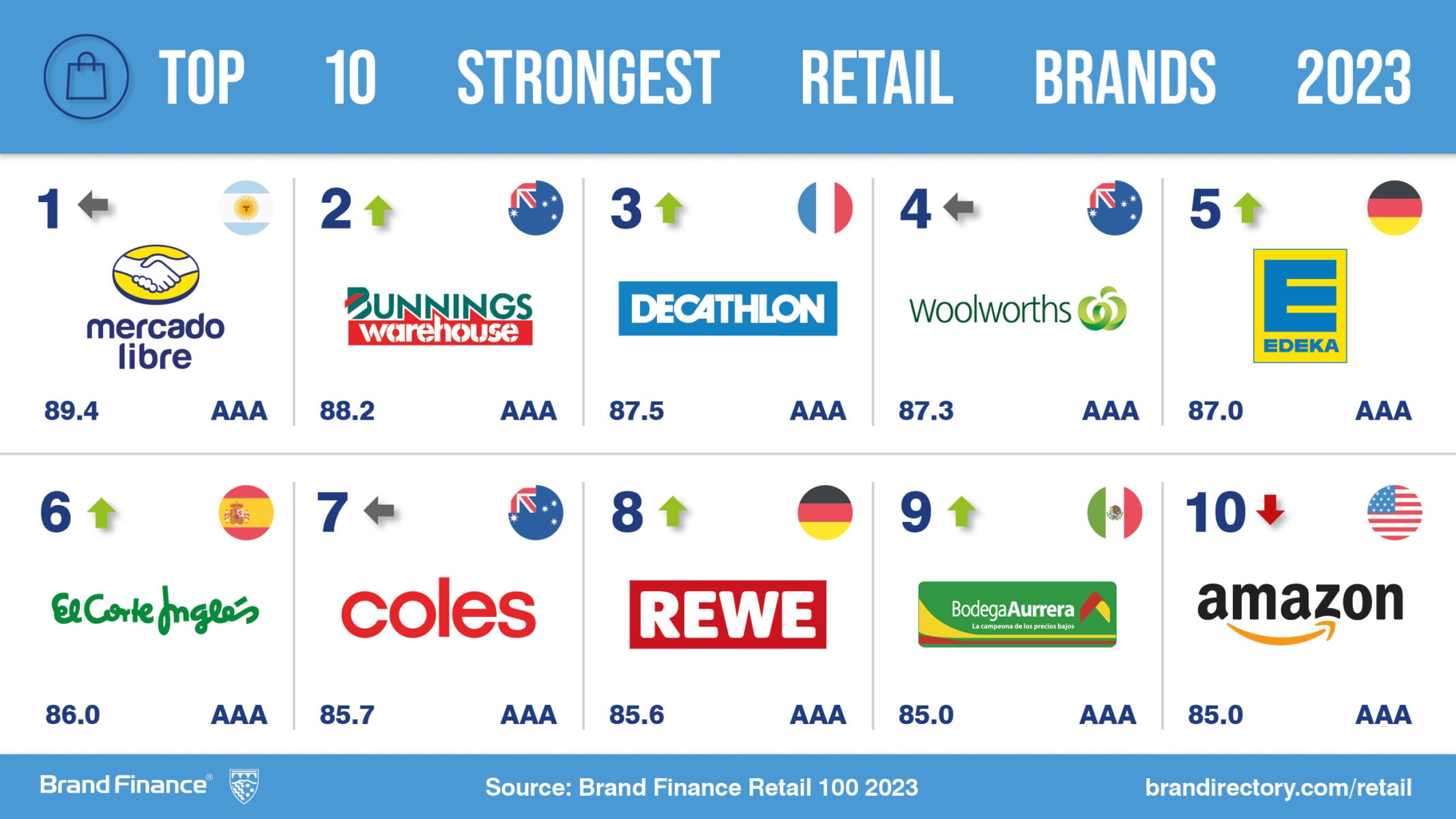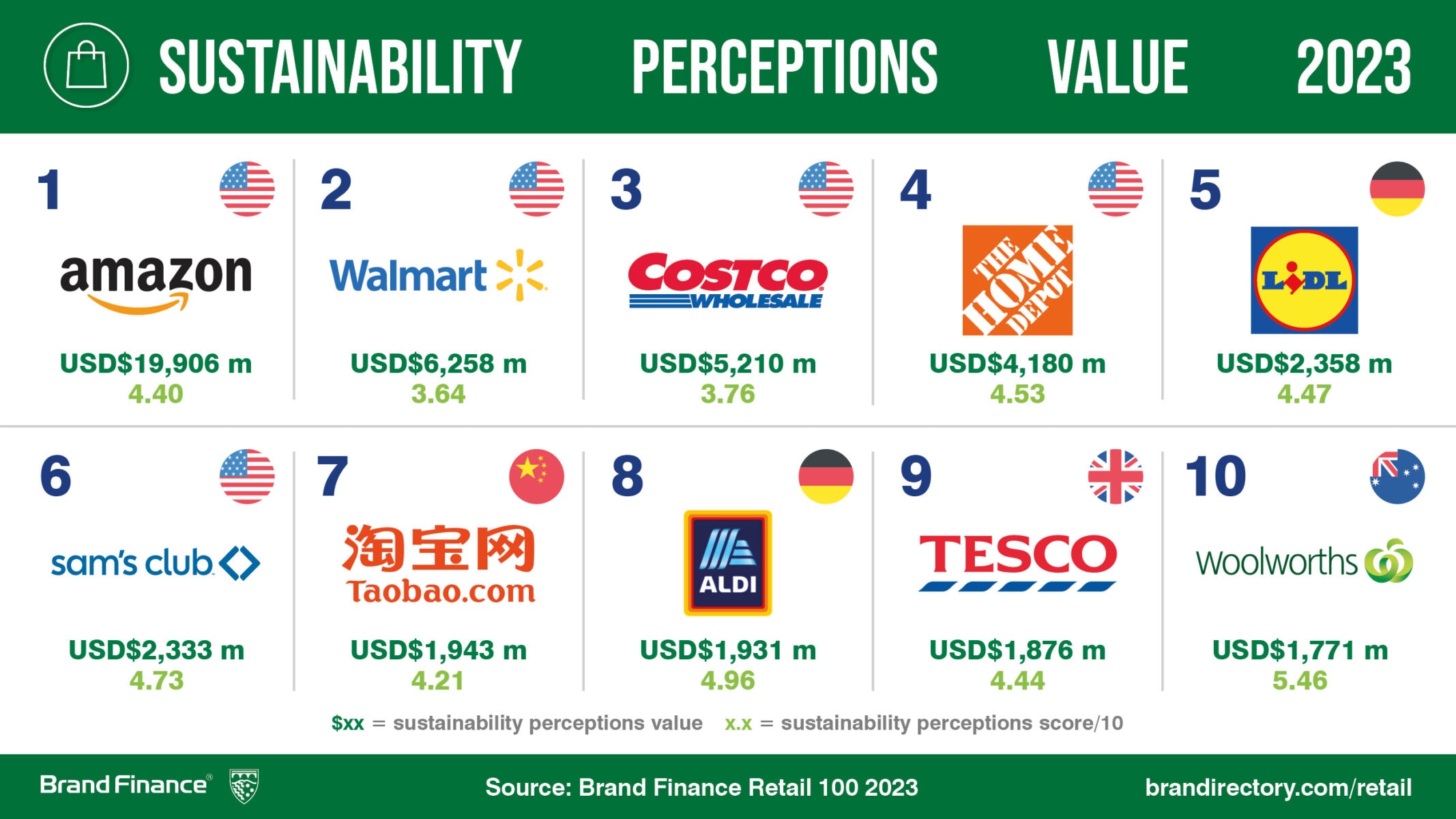View the full Brand Finance Retail 100 2023 report here
Amazon has once again been named the world’s most valuable retail brand, with a brand value of US$299.3 billion, according to leading brand valuation consultancy, Brand Finance. This is more than double the brand value of Walmart (brand value up 2% to US$113.8 billion). Amazon’s brand value has increased 36% since the beginning of the COVID-19 pandemic and is the world’s most valuable brand across all sectors, according to Brand Finance’s Global 500 2023 report.
Richard Haigh, Managing Director of Brand Finance commented:
“The sheer dominance of Amazon in the retail sector – and beyond – cannot be ignored. The brand’s relentless pursuit of customer-centric innovation has not only transformed the way we shop but has challenged and overhauled traditional business models. The retail giant must now look to maintain its competitive edge amid the rapidly evolving landscape, especially as eyes are on the brand now more than ever.”

Mexican retail brand OXXO (brand value up 56% to US$2.3 billion) enters the retail 100 ranking as the fastest-growing brand this year. Its parent-brand Femsa launched an enormous expansion plan for OXXO last year, aiming to increase the number of stores across Latin America by as much as half over the next decade.

ASOS (brand value down 41% to US$1.2 billion) has reported a significant loss as its customers are spending less on fashion due to rising living costs. In general, investor sentiment towards fast fashion firms like ASOS and Boohoo has declined as their growth during the lockdown era fails to translate into post-pandemic profitability. As the fashion giant struggles, ASOS had to write off over £100 million worth of stock after experiencing a slowdown in sales growth.
America’s largest retailer, Walmart (brand value up 2% to US$113.8 billion) holds onto its 2022 rank in second place, while Home Depot (brand value up 8% to US$61.1 billion) maintains third rank. Walmart has benefited from changing consumer spending habits in the post-pandemic world, while the giant has also expanded its advertising initiatives through Walmart Connect, aiming to strengthen the relationships between brands and customers across multiple channels. American home improvement firm Home Depot has also been enhancing its strong reputation for quality and customer satisfaction, in addition to bolstering its sustainability initiatives.
In addition to calculating brand value, Brand Finance also determines the relative strength of brands through a balanced scorecard of metrics evaluating marketing investment, stakeholder equity, and business performance. Compliant with ISO 20671, Brand Finance’s assessment of stakeholder equity incorporates original market research data from over 100,000 respondents in 38 countries and across 31 sectors.
MercadoLibre (brand value down 1% to US$3.7 billion) is the largest e-commerce company in Latin America. The brand has gained consumer trust through its secure transaction platform, MercadoPago, which processed over $100 billion in transactions in 2022. The brand has also expanded its efforts in advertising, further enhancing its brand recognition and familiarity among consumers.

El Corte Inglés (brand value down 39% to US$4.3 billion) has shot up from 53rd place to an impressive 6th for brand strength this year. Following the pandemic, the Spanish retailer launched an initiative to build its strategic alliances. The company secured a strategic deal with Mutua Madrileña Group, while the merger between Viajes El Corte Inglés and Logitravel has solidified the brand’s leadership and enhanced its strong brand recognition in the tourism sector. El Corte Inglés’ acquisition of the Sánchez Romero supermarket chain has also bolstered the brand’s presence in the high-end supermarket segment.
As part of its analysis, Brand Finance assesses the role that specific brand attributes play in driving overall brand value. One such attribute is sustainability. Brand Finance assesses how sustainable specific brands are perceived to be through its annual survey of over 150,000 consumers across 36 countries, represented by a ‘Sustainability Perceptions Score’. The value linked to sustainability perceptions, the ‘Sustainability Perceptions Value’, is then calculated for each brand.
Amazon has the highest sustainability perceptions value of any brand, US$19.9 billion. Amazon has been making strides is in its renewable energy initiatives. As the largest corporate buyer of renewable energy globally, Amazon is committed to powering all its operations with 100% renewable energy by 2025. To achieve this goal, the brand has already announced more than 400 projects as of January 2023, highlighting its notable progress in this endeavour.

Brand Finance is the world’s leading brand valuation consultancy. Bridging the gap between marketing and finance, Brand Finance evaluates the strength of brands and quantifies their financial value to help organisations make strategic decisions.
Headquartered in London, Brand Finance operates in over 25 countries. Every year, Brand Finance conducts more than 6,000 brand valuations, supported by original market research, and publishes over 100 reports which rank brands across all sectors and countries.
Brand Finance also operates the Global Brand Equity Monitor, conducting original market research annually on 6,000 brands, surveying more than 175,000 respondents across 41 countries and 31 industry sectors. By combining perceptual data from the Global Brand Equity Monitor with data from its valuation database — the largest brand value database in the world — Brand Finance equips ambitious brand leaders with the data, analytics, and the strategic guidance they need to enhance brand and business value.
In addition to calculating brand value, Brand Finance also determines the relative strength of brands through a balanced scorecard of metrics evaluating marketing investment, stakeholder equity, and business performance, compliant with ISO 20671.
Brand Finance is a regulated accountancy firm and a committed leader in the standardisation of the brand valuation industry. Brand Finance was the first to be certified by independent auditors as compliant with both ISO 10668 and ISO 20671 and has received the official endorsement of the Marketing Accountability Standards Board (MASB) in the United States.
Brand is defined as a marketing-related intangible asset including, but not limited to, names, terms, signs, symbols, logos, and designs, intended to identify goods, services, or entities, creating distinctive images and associations in the minds of stakeholders, thereby generating economic benefits.
Brand strength is the efficacy of a brand’s performance on intangible measures relative to its competitors. Brand Finance evaluates brand strength in a process compliant with ISO 20671, looking at Marketing Investment, Stakeholder Equity, and the impact of those on Business Performance. The data used is derived from Brand Finance’s proprietary market research programme and from publicly available sources.
Each brand is assigned a Brand Strength Index (BSI) score out of 100, which feeds into the brand value calculation. Based on the score, each brand is assigned a corresponding Brand Rating up to AAA+ in a format similar to a credit rating.
Brand Finance calculates the values of brands in its rankings using the Royalty Relief approach – a brand valuation method compliant with the industry standards set in ISO 10668. It involves estimating the likely future revenues that are attributable to a brand by calculating a royalty rate that would be charged for its use, to arrive at a ‘brand value’ understood as a net economic benefit that a brand owner would achieve by licensing the brand in the open market.
The steps in this process are as follows:
1 Calculate brand strength using a balanced scorecard of metrics assessing Marketing Investment, Stakeholder Equity, and Business Performance. Brand strength is expressed as a Brand Strength Index (BSI) score on a scale of 0 to 100.
2 Determine royalty range for each industry, reflecting the importance of brand to purchasing decisions. In luxury, the maximum percentage is high, while in extractive industry, where goods are often commoditised, it is lower. This is done by reviewing comparable licensing agreements sourced from Brand Finance’s extensive database.
3 Calculate royalty rate. The BSI score is applied to the royalty range to arrive at a royalty rate. For example, if the royalty range in a sector is 0-5% and a brand has a BSI score of 80 out of 100, then an appropriate royalty rate for the use of this brand in the given sector will be 4%.
4 Determine brand-specific revenues by estimating a proportion of parent company revenues attributable to a brand.
5 Determine forecast revenues using a function of historic revenues, equity analyst forecasts, and economic growth rates.
6 Apply the royalty rate to the forecast revenues to derive brand revenues.
7 Discount post-tax brand revenues to a net present value which equals the brand value.
Brand Finance has produced this study with an independent and unbiased analysis. The values derived and opinions presented in this study are based on publicly available information and certain assumptions that Brand Finance used where such data was deficient or unclear. Brand Finance accepts no responsibility and will not be liable in the event that the publicly available information relied upon is subsequently found to be inaccurate. The opinions and financial analysis expressed in the study are not to be construed as providing investment or business advice. Brand Finance does not intend the study to be relied upon for any reason and excludes all liability to any body, government, or organisation.
The data presented in this study form part of Brand Finance's proprietary database, are provided for the benefit of the media, and are not to be used in part or in full for any commercial or technical purpose without written permission from Brand Finance.